Projects and Science
France
Bride´s- or wedding distaff
ABT
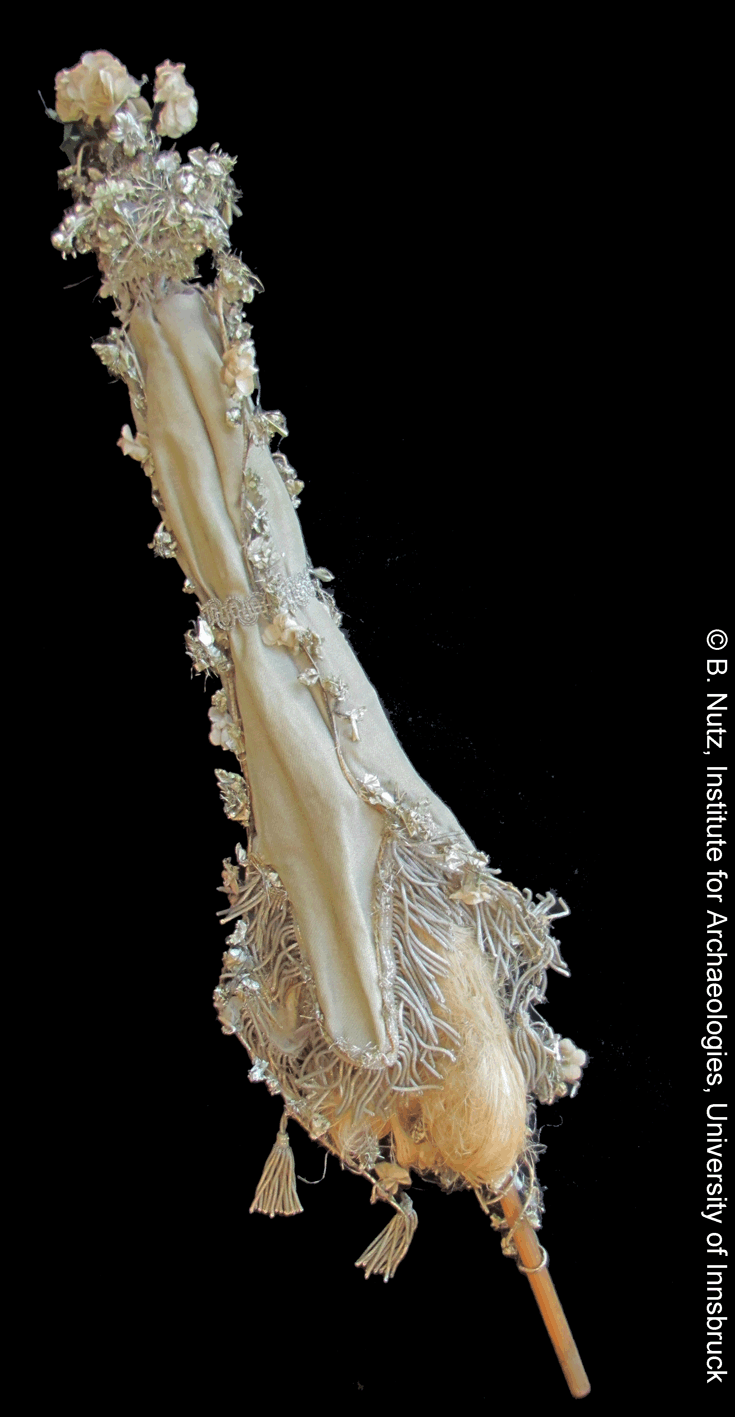
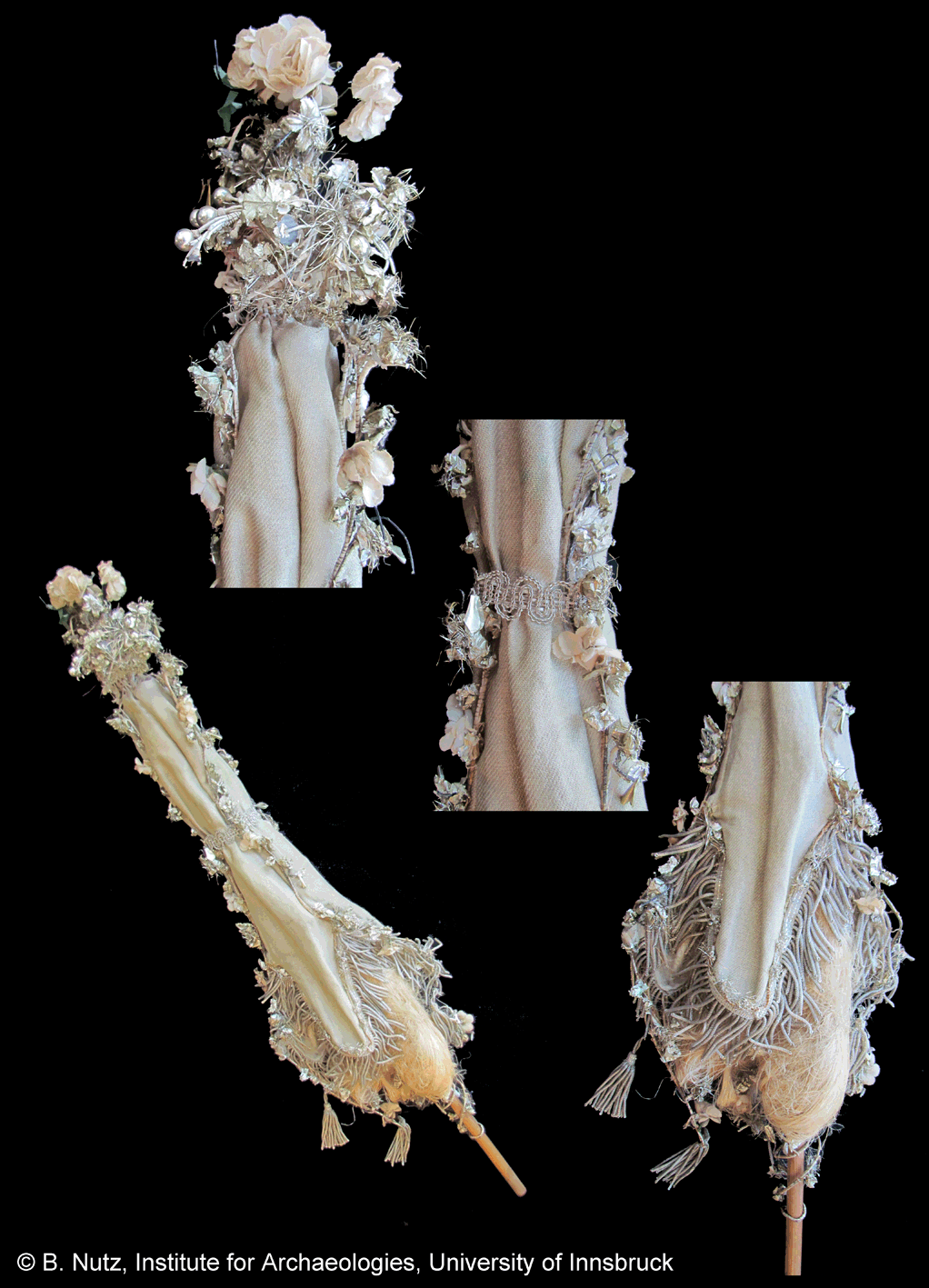
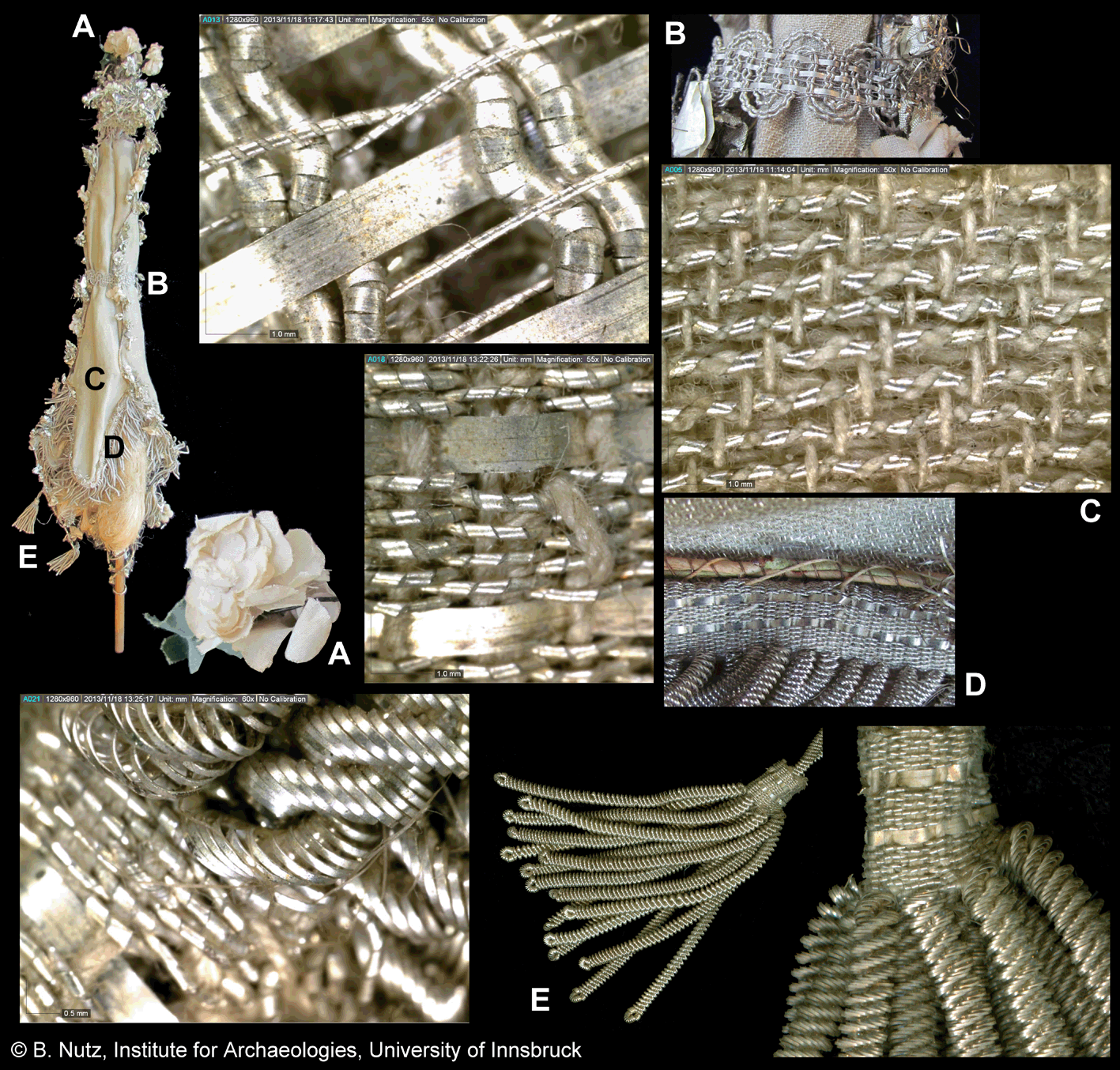
A: Fabric rose at the top. B: bobbin lace ribbon with silver threads and flattened silver wire around the middle of the distaff. C: fabric in 1/3 twill weave with silver threads. D: border with silver warp threads and flattened wire. E: tassel made of flattened wire. The flattened wire used is probably nickel silver. Nickel silver is a copper alloy with nickel and often zinc. Nickel silver is named for its silvery appearance, but it contains no elemental silver unless plated.
The distaff of newlyweds
Chateaubriand wrote in his book "Génie du Christianisme": "The bride receives the blessing from the priest for her engagement and lays a distaff decorated with bands down on the altar". The great writer refers in this text to a then popular custom which was, up to the second half of the last century (19th century), still well known in many parts of the country.
This practice is also described in the 16th century by G. Bouchet in his memorable work "Les Sérées". "In the past," writes the author, "a distaff, fitted with wool and a spindle, was carried in front of the bride as she walked to the house of the groom to remind her of her duty to spin and do nothing else." Although this tradition had already been abandoned in the time of this author, another custom was still in force: to put a beautiful distaff with flax on the altar of the Virgin Mary on the occasion of the wedding.
This custom existed in Normandy and numerous authors have reported it. In the 18th and, undoubtedly, the 19th centuries in Étienville (Dép. Manche) a distaff permanently remained next to the statue of the Virgin. On the first Sunday after the wedding night the young bride or her bridesmaid had to fasten a band there and give a ball of linen yarn to the church.
Around 1880 J. Lecœur also describes the ceremony in the Bocage1 (Normandy): "A few hours after the wedding the young bride leaves her apartment accompanied by her groom and her relatives. She carries a distaff with flax and decorated with ribbons that had been on the dowry wagon. The train walks to the church, attends the mass, and when the service is finished the bride kneels before the altar of the Virgin Mary. After a prayer she gets up and puts her peasant votive offering in front of the revered image. This offering remains there until it is replaced by the distaff of another bride. In former days the new bride bore away the distaff which she exchanged with her own and spun the flax that was on it. Her distaff awaited the following bride so there was never a lack of thread, neither in the sacristy nor in the rectory."
In his amusing description of a wedding night at the beginning of the 19th century in the vicinity of Pont- Audemer (Dép. Eure), J. Lecœur does not fail to mention the transport of the dowry which was surmounted by a distaff equipped with flax and bands, attached under the supervision of a close relative of the future wife. "This object." he writes, "was provided so that the young woman knew how to keep herself busy with regard to the prosperity of her household."
In his dictionary of Mayenne Pastor Angot calls attention to the use of the distaff of a young wife in Saint- Jean-sur- Mayenne (Dép Mayenne). This custom existed in the Perche2 and carried the poetic name "thread of the Virgin". In the Beauce3 next to Normandy, balls of hemp were also sacrificed by young women. In the 19th Century, in the area of Chartres and Berry4, the young bride spun either in the church or on the porch of the church. Around 1870 the bride either turned around to the altar of the Virgin or to the statue of St. Anne before she left the altar area. There a servant of the church handed her a distaff decorated with carvings and bands and well-stocked with tow. She took it with her for spinning. This custom was practiced in Anneau in 1896. Albert Dauzat wrote that in the same year a bride of southern origin refused to follow that custom! At the same time in Meslay de Grenet (Dép. Eure-et-Loire) - the church is famous for its dance macabre - the young village women subjected themselves to this custom. Some time ago in this little church you could still see a very old distaff of the 18th Century near the altar of the Virgin that was put there in her honor. The finely engraved rod was much admired by visitors - perhaps a little too much - because now this strange folkloric piece is gone.
We find this tradition again in the Berry. We leave the description to a local historian, Adrien de Barral, who studied the distaff of godfathers, godmothers and brides in the "Revue du Centre" in 1886: "In one part of the Berry - among others in the vicinity of Bourges - you can see eight or ten distaffs in the chapel of the Virgin. They are placed on a sort of coat rack made of wood. These distaffs have carved sticks decorated with leaf and flower tendrils, with zigzag and floral decoration in relief. At the top the tow is wrapped with different colored ribbons, their ends hanging down. … The custom is: after each baptism one of the distaffs is given to the godmother. She takes it home, spins the hemp, puts new tow on the distaff and decorates it again. Usually the old distaff is also replaced by a new one: The godfather designs the new distaff and decorates it according to his taste and artistic ability. The Godmother gives the new distaff and a new package of tow to the sexton. The spun yarn is processed into textiles for the church."
"The brides also get a distaff. On the Sunday following the wedding night the sexton gives the new wife her distaff during the High Mass. Just as the godmother she equips it with tow and her spouse also carves a new ornate distaff."
In some villages in the Île-de –France5 in the chapels dedicated to the Virgin small objects that belong to the female area of life can be seen. The brothers Seignerolle listed in their book on the folklore of Hurepoix6 (Île-de-France), that this custom was disappearing around 1930. On the other hand: at Saint-Cheron (Dép. Essonne) the sexton lets the bride kiss (embrace) the distaff that remains in the church.
In Saint –Lambert7 the bride brought a piece of her veil to church on her wedding day, which then remained there for a year. On the following Sunday the young girls gave her a distaff so that she may learn to spin with it. When a bride returned to church for the first time for mass in Voisins-le-Bretonneux (Dép. Yvelines) one of her attendants handed her a distaff which was nothing but a plain stick wrapped and decorated with lace and orange blossoms. The young woman had to kiss this simulacrum and donate a coin.
In a great book about folk art the undisputed expert on French folklore, A. van Gennep, has recently published a drawing of a bride´s distaff, discovered in Sainte-Geneviève-des Bois (Dép. Seine-et-Oise8). This interesting device is decorated with very naive patterns and displays the priest, the bride and various religious symbols.
In Brie9 in this tradition was highly valued: The traveler Goudemez visited the Church of Champeaux at Meaux (Dép. Seine-et -Marne) in 1786 and noted: "it is the custom that when a young woman marries she places a self- decorated distaff on the altar of the Virgin."
This custom also existed in other provinces, for example in Brittany10 and Poitou11. We hope that many bride´s distaffs will be discovered during the investigations of the Federation folklorique d' Île-de -France and the Comité de folklore normand in broom closets and chambers of churches. We also hope that we can also rescue the little odds and ends, last witnesses to often centuries- old customs, from oblivion and destruction.
Translation from: Roger Vaultier, Les quenouilles de mariées. Le Chasseur Français N°640, Juni/June 1950, Seite/page 381 (French-German: Helga Marchhart; German-English: Beatrix Nutz).
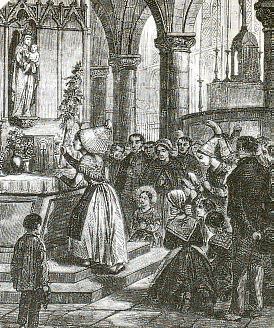
Offering of the distaff on the altar of the Virgin on the day after the wedding night.
Literature:
Arnold van Gennep, Manuel de folklore français contemporain 1/II. Du berceau a la tombe. Mariage – Funerailles (Paris 1946), 465-469.
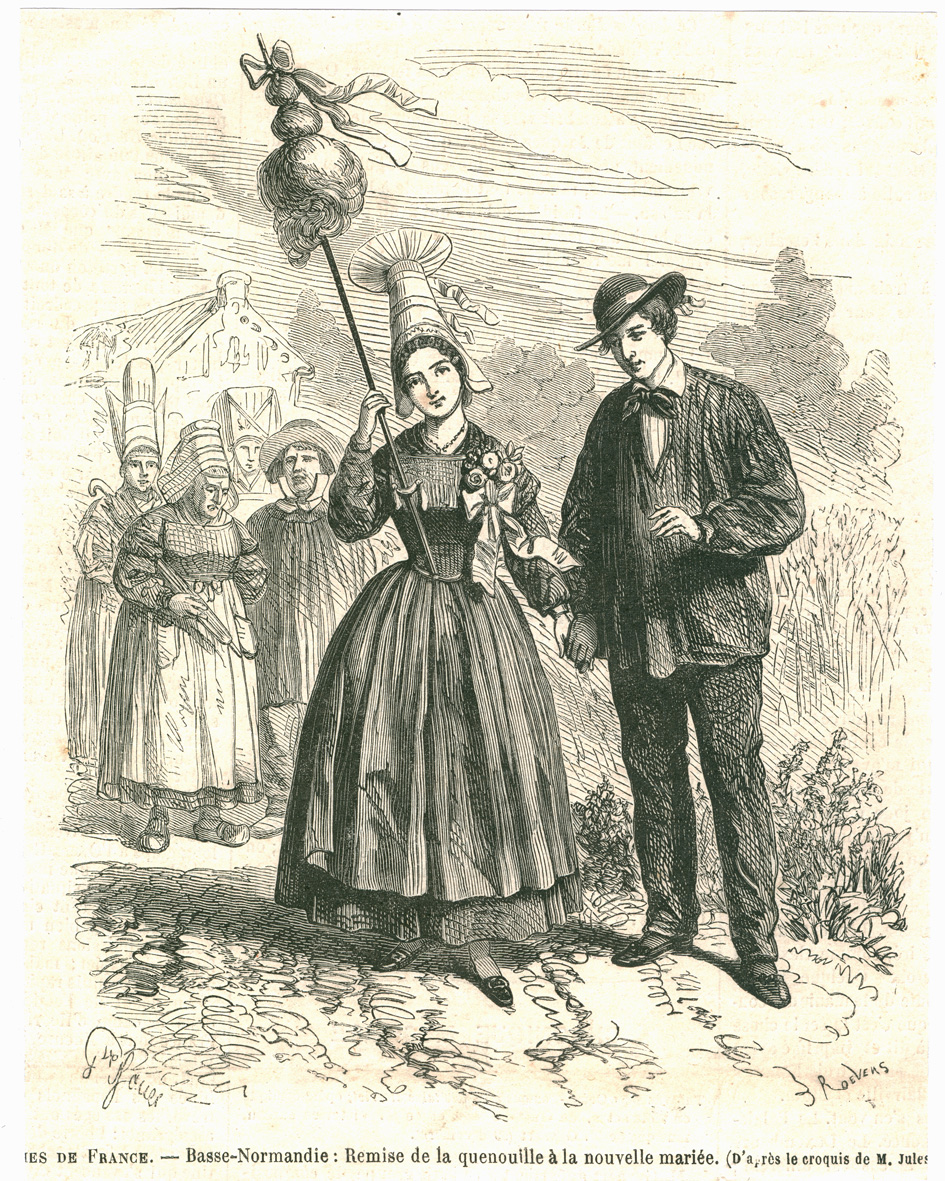

1 Bocage is a Norman word which has entered both the French and English languages. It may refer to a small forest, a decorative element of leaves, a terrain of mixed woodland and pasture, or a type of rubble-work, comparable with the English use of 'rustic' in relation to garden ornamentation. Villers-Bocage is a commune in the Calvados department in the Basse-Normandie region in Northern France.
2 Perche is a former province of northern France extending over the départements of Orne, Eure, Eure-et-Loir and Sarthe.
3 Beauce is a natural region in northern France, located between the Seine and Loire rivers. It now comprises the Eure-et-Loir département and parts of Loiret, Essonne and Loir-et-Cher.
4 Berry is a region located in the center of France. It was a province of France until the provinces were replaced by départements on 4 March 1790. The Berry region now consists of the départements of Cher, Indre and parts of Vienne.
5 The Île-de-France is a region in northern France, which is mostly identical to the Paris metropolitan area. The region consists of the city of Paris and the departments of Essonne, Hauts-de-Seine, Seine-et-Marne, Seine-Saint-Denis, Val-d'Oise Val-de-Marne and Yvelines.
6 Hurepoix is an area of Île-de-France, in the south west of Paris. Situated between the departments of Yvelines, Hauts-de-Seine and Essonne, it was an old province of the French Kingdom.
7 Either Dép. Yvelines or Calvados.
8 Today: Dép. Essonne.
9 Brie is a historic region of France corresponding roughly to the modern department of Seine-et-Marne.
10 Brittany is a region of western France. It now consists of the Dép. Côtes-d'Armor, Finistère, Ille-et-Vilaine and Morbihan.
11 The Poitou is a landscape in the west of France and was a historical province and county. The area corresponded approximately to the present-day departments of Deux-Sèvres, Vienne and Vendée.